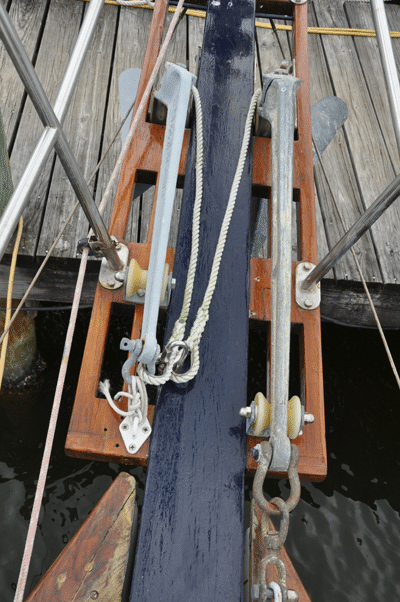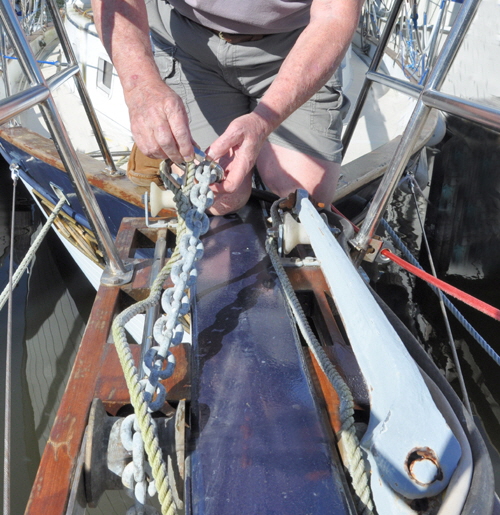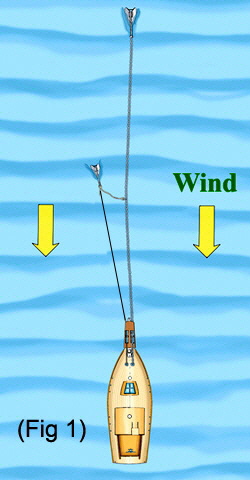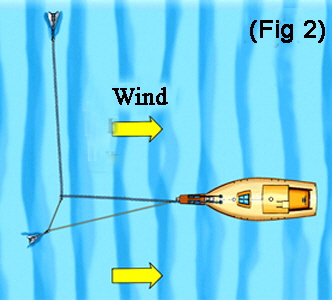 Britannia has a unique anchoring system that ensures a firm grip on the sea bed using both bow anchors in tandem.
Britannia has a unique anchoring system that ensures a firm grip on the sea bed using both bow anchors in tandem.
Britannia has two CQR anchors on rollers on either side of the bowsprit. The main bower is a 60 lbs and the other weighs 35 lbs. The 60 pounder is on 250’ feet of 3/8” inch chain with a further 250’ feet of 3/4” inch nylon line, used for deep anchorages. The smaller 35 lbs anchor has no chain or rope attached to it at all, and is used only in conjunction with the main bower. Of course, it can always be used separately, but the method uses the second anchor attached to the chain in such a way that it not only acts like a heavy kellett, but actually digs into the sea bottom.
 A strong rope bridle using a 5/8” inch diameter nylon line with stainless thimbles spliced on each end is permanently shackled to the stock of the 35 lbs anchor, then it passes around the underside of the bowsprit and bobstay and up the roller of the main anchor, on the other side of the bowsprit.
A strong rope bridle using a 5/8” inch diameter nylon line with stainless thimbles spliced on each end is permanently shackled to the stock of the 35 lbs anchor, then it passes around the underside of the bowsprit and bobstay and up the roller of the main anchor, on the other side of the bowsprit.
After letting go the main anchor and paying out two or three times the depth, the boat is allowed to fall back with the wind or current, or driven back with the engine until it feels as though the anchor has begun to hold. The rope bridle is then attached to the anchor chain with a locking carabiner shackle that goes through a link; the other end still being attached to the shank of the second anchor. A length of strong line is then shackled to the shank of the second anchor,
The second anchor is then pushed off its roller, where it hangs by the bridle on the chain. More chain is then let out and the boat allowed to fall back. This is usually an extra two or three times the depth. When the second anchor touches the bottom, that can be felt with the line attached to it and the slackness of the chain, a hefty burst on the engine drags beds both anchors simultaneously to the bottom.
 There is now the heavy main anchor well bedded in at the head of a good length of chain, with the second anchor attached to it by the bridle and also bedded in, then another length of chain up to the boat. This gives Britannia a total of 95lbs of anchors complimented by a load of heavy chain.
There is now the heavy main anchor well bedded in at the head of a good length of chain, with the second anchor attached to it by the bridle and also bedded in, then another length of chain up to the boat. This gives Britannia a total of 95lbs of anchors complimented by a load of heavy chain.
Anchoring using this method can be as quick as any boat using a single anchor, but with a good deal more peace of mind if the wind pipes up. But, when day-sailing the main anchor I will hold in the normal way.
 Fig 1 shows how the anchors lie after normal deployment. But if the wind shifts say 90 degrees, the boat will initially swing to the second anchor, as in Fig 2, but if this drags it will pull the chain around with it and invariably dig in again. If it refuses to hold, the whole rode will eventually straighten out in the new direction and the boat will lie to the first anchor and most likely also the second.
Fig 1 shows how the anchors lie after normal deployment. But if the wind shifts say 90 degrees, the boat will initially swing to the second anchor, as in Fig 2, but if this drags it will pull the chain around with it and invariably dig in again. If it refuses to hold, the whole rode will eventually straighten out in the new direction and the boat will lie to the first anchor and most likely also the second.
Weighing anchor is a little bit more effort than with a single anchor. The chain is hauled in with the Maxwell windlass until the second anchor appears, when it can be cleaned and hauled over its bow roller using the line attached to its stock, then secured and the bridle and line unshackled from the chain. At this point the boat is still securely anchored by the first anchor. The main anchor is then brought up in a normal way and off you go. The portable anchor wash system is described here
Using this method has never dragged on Britannia, and there are other benefits to the system. It is much easier and quicker to use this method instead of laying two separate anchors, say at 45 degrees. No tricky maneuvering is needed and no chance of the twin rodes tangling if the boat swings.
It is certainly worth anchoring well, even in a flat calm and a good forecast, because old Neptune is known to frequently change his mind
.
